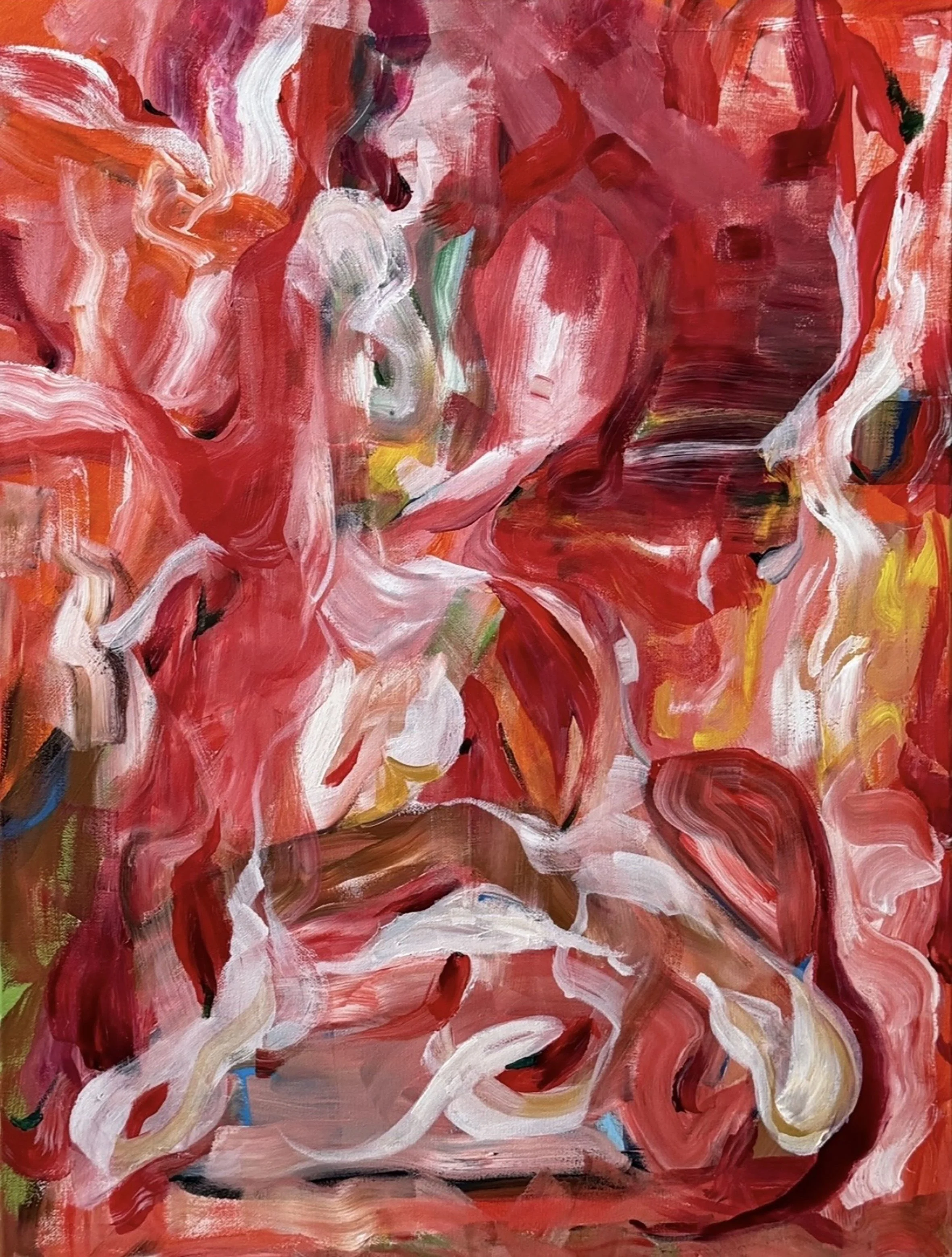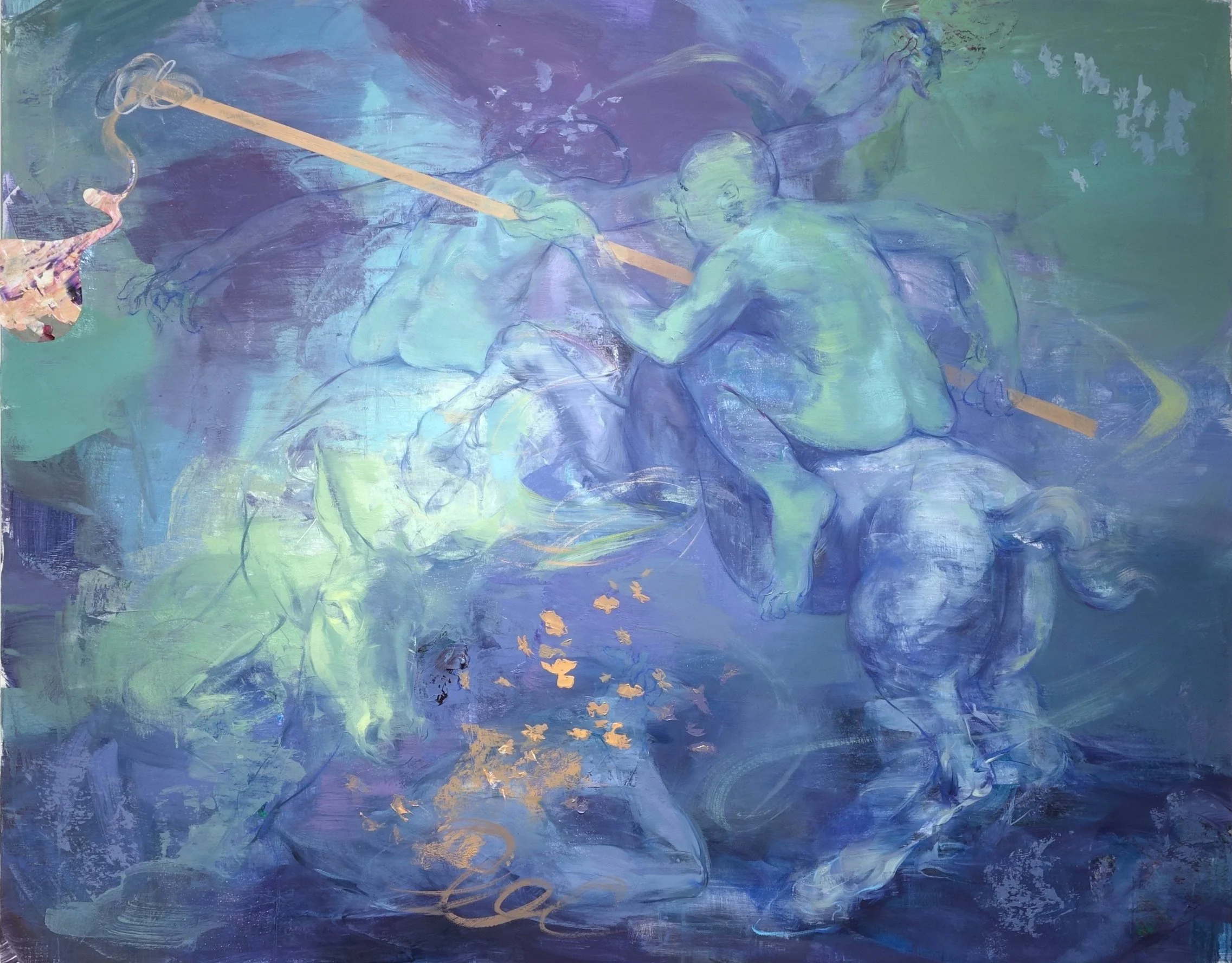10 Questions with Veronika Spleiss
Veronika Spleiss, born 1993 in Tallinn and whose roots lie in Estonia and Russia, has worked with fine visual arts for more than fifteen years. She learned painting, graphics, and illustration techniques during many years of lessons with the artist Natalia Zurakowska. After studying French and Russian literature as well as political theory in Munich, Clermont-Ferrand and Passau (Master of Arts), she turned her attention to artistic creation as a whole, which produced and continues to produce her series "Following the black lines", "Life Series" and "Paths". Spleiss has exhibited in multiple exhibitions and international art fairs in Germany, Switzerland, and the USA. In addition, her art can be found in private collections all over the world, such as Japan, France, and Switzerland. Veronika Spleiss lives and works between Munich and Passau.
Veronika Spleiss Portrait
ARTIST STATEMENT
Her paintings are obviously chaotic, but they have an inherent order and harmony that only emerges on further contemplative viewing. So it is with life itself. If life can all too often appear chaotic, it has its structures in all its facets and perspectives. The paintings of the artist Veronika Spleiss illustrate this process mostly in a two-dimensional style, but due to their variety of forms they stand for a multi-perspective opening to life.
In the spirit of Friedrich Nietzsche, the aspect of perspective is shown as the "basic condition of all life" because life encompasses a whole. But the man himself has no access to it. The living person is always bound to their own perspective and view of the world, which has a certain order of its own. The artists play with these aspects. What's more, she tries to visualize life graphically in its versatile perspectives. For the viewer, this primarily means chaos - a supposedly chaotic combination of different points of view that emerge from black or rather a nothingness. Each particle, each geometric form, stands on its own but approaches the other forms and thus establishes a necessary connection. In the end, the work becomes a panorama of a city, a combination of houses, people, stairs with their own order: an order of perspectives.
INTERVIEW
What is your artistic background, and how did you start experimenting with images?
I had many years of private lessons with the artist Natalia Zurakowska in Munich, Germany. When I was young, I would bring her folders of new work on a regular weekly basis. Each work was different in style, elaboration, and intention. But there were also many works that I painted only for training, such as the often grotesque portrait sketches of Leonardo da Vinci. In fact, the beginning of my present graphic style comes from one of my own works during this very productive period. I later reinterpreted it and developed my style from this. It's called "Eine helfende Hand "(A Helping Hand).
Why are you an artist, and when did you first become one?
It is difficult to determine why someone becomes an artist. It's simple - you become one when you subliminally search for it and finally consciously choose this life. And until then, it is a long and psychological process. In my case, I suppressed the need and my predisposition to become an artist for a long time, knowing that experience, steadfastness, and an irrepressible will are necessary to actually become an artist. I was not ready for this in my youth. Because art is primarily work, as it is also working on oneself. At some point, however, you sense in yourself the right time. For me, this moment came in the course of my master's studies at the University of Passau, when I began to study political theory, especially in connection with the philosophy of Friedrich Nietzsche and Byung Chul-Han as well as the "neoliberalism" of our present time.
Wegleben (Path Life), Acrylic on canvas, 80x120 cm, 2019 © Veronika Spleiss
Can you tell us about the process of creating your work? What is your artistic routine when working?
My working method is always different at the beginning of each work, and that has something to do with my character, which needs a lot of variety - also in the working process. I very often change my workplace in the studio or rearrange it.
Usually, I first create a rough sketch of an idea, which is especially about interpersonal relationships. This sketch is not worked out immediately, but a few months later. Because there is always another piece I am working on, and my works take a long time. For example, I worked on "Schwankungsleben" (Fluctuation Life) for about three months. If a work occupies me too much, I also take a break and start a new work. This work can also be started spontaneously without sketching or preparation. In these works, I see where it takes me. So my studio may be now and then full of unfinished works - but they will all be completed eventually.
I usually listen to movies I've already seen or audiobooks in different languages while I paint. However, if I want to concentrate even more during certain phases, I listen to classical music. Also, coffee may not be missing in the work process, which lasts best directly in the morning until the afternoon. For each of my works, I write a short text to become more aware of my work in retrospect. I think them through. My earlier study of literature certainly influences this way of working.
Your work often refers to chaos. How can you turn chaos into very balanced works?
The balance arises from the exactness of the black lines, their composition, and the reduced choice of color. Depending on whether the viewer wants to deal with one of my works, he finds new structures, connections, and perhaps meaning for himself behind it. At first glance, my works probably appear simply "colorful". But it is more about holding out extremes of colors and shapes and harmonizing this tension field.
Let’s talk about the colors in your paintings. Do they have a specific meaning for you? How do you choose them?
I reflect on the themes of my works in the life series: overcoming life, freedom life, way of life, learning life, etc. The color choice of my works, on the other hand, is purely intuitive. It often happens that I change the colors already applied to the canvas again if it seems to me, for example, too unsuitable to the composition and theme. The colors must feel right in a piece.
Schwankungsleben (Fluctuation Life), Acrylic on canvas, 100x120 cm, 2021 © Veronika Spleiss
Folgeleben (Following Life), Acrylic on canvas, 135x145 cm, 2020 © Veronika Spleiss
How much planning goes into each artwork?
Primarily I draw a simple sketch on the philosophical topic that I have thought about. My sketchbooks are full of ideas and topics that occupy me in my everyday life. This pencil sketch is intended to represent only the overall composition of a work. The details are applied directly to the canvas with a brush and usually black acrylic paint. My works are very precise, and every black stroke must be right. In this, I am often even too perfectionist and could thus work forever on a painting.
What does your art aim to say to the viewers? And what do you think differentiates your message from those of other artists?
My works are strongly related to the extremes and interpersonal relationships, both stylistically and theoretically. Although the human being is represented in my works yet very abstract, he has a definitive meaning. He is at the center of my works. It is the human being in the confusion of our time. But this confusion has its inherent order and harmony, which emerges only with further contemplative vision. It is like life itself. It appears confusing, unpredictable, and versatile. My works are painted two-dimensional but open a variety of forms and a view of the many perspectives. If they take on a perspective direction, it changes again. Entirely in the sense of Friedrich Nietzsche "[...] the perspectival, the basic condition of all life" is shown (JGB, KSA 5, p. 12), for life comprises a whole. But the man himself has no access to this. The living person is always bound to his perspective and view of the world, which has a certain inherent order. I try to visualize this life graphically from versatile perspectives. For the viewer, this means primarily a supposedly chaotic assemblage of different perspectives, which emerge from the black of nothingness. Each particle, each geometric form, stands on its own but approaches the other forms and thus establishes a necessary connection. In this sense, the multifaceted perspectives come together and become a story all their own for the artist and the viewer. What makes the difference to other artists is specifically the abstract representation of the human being in its various constellations and the philosophical writing of my thoughts on each work.
Das Dreiergespann (The Trio), 30x30 cm, 2020 © Veronika Spleiss
Do you find that the shift to digital exhibitions and art fairs has helped you promote your work?
In a way, yes. But digital exhibitions are less enriching because the personal exchange with the viewer is missing. It's a plus for social media, but nothing more. I still prefer actual exhibitions. Especially since my works obviously come into their own best in their textures, materiality, and size.
Goliath oder Kampfleben (Goliath or Battle Life), Acrylic on canvas, 80x80 cm, 2019 © Veronika Spleiss
What are you working on right now? Any exciting projects or exhibitions coming up soon?
I am working on a series of three, which appear like a stained glass window. It is about time in three stages of life, which can be equated with childhood as lightness, adulthood as seriousness, and old age as tranquility.
My next exhibitions return in August 2021 after a long Corona hiatus. The month starts with a juried group exhibition in Wasserburg am Inn about the Arbeitskreis 68. After that, it continues with a group exhibition in the Farbenladen in Munich. And already August ends with the art fair Kunst/Mitte in Magdeburg Germany, where I exhibit with the French art gallery justBEE. In November 2021, there is another exhibition in the cultural center Trudering in Munich under the motto "The story of the eight hands". And after that, it's off to the art fair at the Women's Museum in Bonn, where I've been nominated for the Renate Hendricks & Valentine Rothe Prize. If no third wave awaits us, I will then go to Red Dot Miami in Florida, USA in December 2021.
Finally, any shows, galleries, or publications where our readers can find your work?
My works are shown at the Prince House Gallery in Mannheim, Germany, and the French gallery justBee. Some of my work can be viewed online through the French online art gallery Singulart and the American online art gallery Saatchi. You are also welcome to contact me directly on Instagram, where I show the process of my work.


























